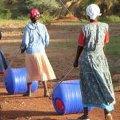Emily Pilloton was set on her path in life early on, by her entrepreneur father and a business-oriented mother who stressed the importance of helping others.
"I somehow ended up as a sort of perfect cross-section of the two of them," she says, "wanting to be an entrepreneur but also having a sort of humanitarian spirit." With degrees in architecture and product design, Pilloton started to make 'green' furniture in Chicago. She soon recognized that she wouldn't be able to make much of a living doing that, so she moved back home to the San Francisco Bay area. Life-changing epiphany A retail clothing company hired Pilloton as a store designer. But three weeks into the job, after a lengthy, heated group discussion about doorknobs, Pilloton realized how misdirected her design skills had become.
She recalls that was the moment she made a promise to herself, "that from that day forward, I was only going to work on design projects that mattered, to really apply my skill set to address the social, humanitarian issues." So Pilloton went to work as managing editor of a website devoted to the future of design and its use in a socially responsible way. With Inhabitat.com, Pilloton had a forum where she could articulate her principles and values. As she did so, she gathered a network of like-minded colleagues.
New design focus In 2008, Pilloton started her own organization, Product Design Initiatives for Humanity, Habitats, Health and Happiness, better known as Project H. It's a collaboration of designers, architects and builders who want to use design to make the world a better place. "It was really, honestly, a way for me personally to just put a stake in the ground and say, 'This is the moment when we're going to turn our criticism into action,'" Pilloton says. With a relatively tiny budget, Project H has gone from an idea in Pilloton's head to an organization with hundreds of members around the world, nine local chapters and 20 completed projects, with 25 more in the works. An early project was a book of inventions Pilloton compiled called, "Design Revolution: One Hundred Products That Empower People." Adjustable eyeglasses and rolling water barrels Pilloton's choices for the book include such devices as 'adaptive eye care.' The affordable eyeglasses have a syringe on each earpiece, filled with a special fluid. The wearer can twist a knob to control the amount of liquid in each lens.
"So as you adjust the amount of liquid in that lens," says Pilloton. "It changes the concavity of the lens and that's the prescription. Literally, you can set your own prescription in 15 seconds." Another Pilloton favorite is the hippo roller, which Project H helped distribute in South Africa. The water transport barrel is designed to cut down on trips to a water source that may be as far away as 10 kilometers.
"Instead of carrying water on your head, which is not just inefficient but taxing on the human body, you can push along the ground," says Pilloton. She says the hippo roller makes bringing up to 83 liters of water back to a village safer and more efficient.
Taking her mission on the road Pilloton's "Design Revolution" was released in August. But instead of going on a traditional book tour, she decided to do something different to promote her book and her belief that good design can change the world.
She packed up a vintage Airstream travel trailer with 40 inventions featured in the book, and set off on a 75-day cross-country tour. At each stop, she shows off the products and what they can do.
She says it helps to be traveling in a hard-to-miss silver trailer with a bright pink stripe. "We wanted to use it as a way to bring some fun and accessibility to the content," she says, "to show up in places all around the country, primarily at design schools and high schools, to really catalyze the next generation of design thinkers and creative problem solvers." Creative problem solving will continue even after the 'Design Revolution Road Show' ends in mid-April. The trailer will be parked in a poor rural community in North Carolina, where Project H volunteers are already working with teachers, artists, builders and architects.
Emily Pilloton is making the state her organization's home for the next couple years, to focus on creating innovative designs to improve education.

